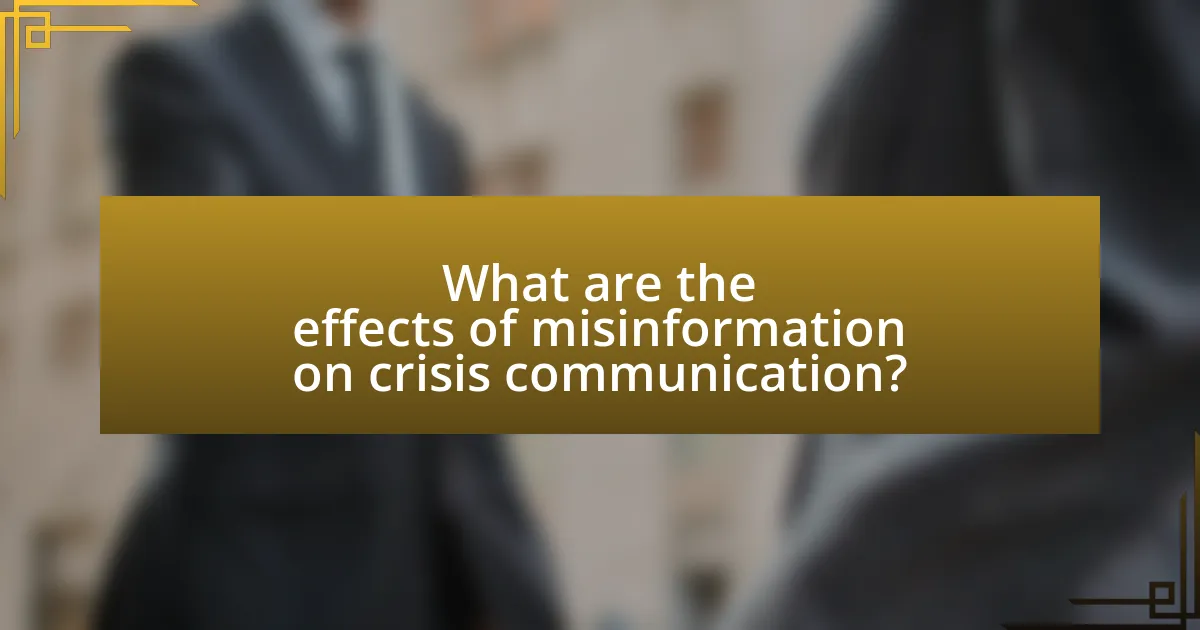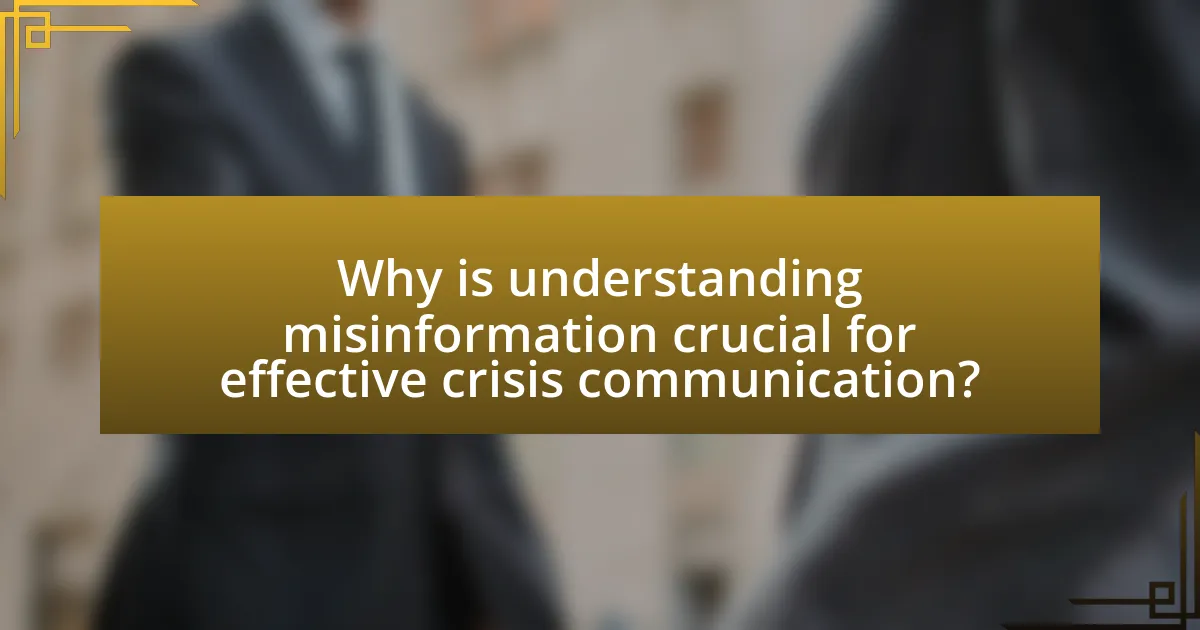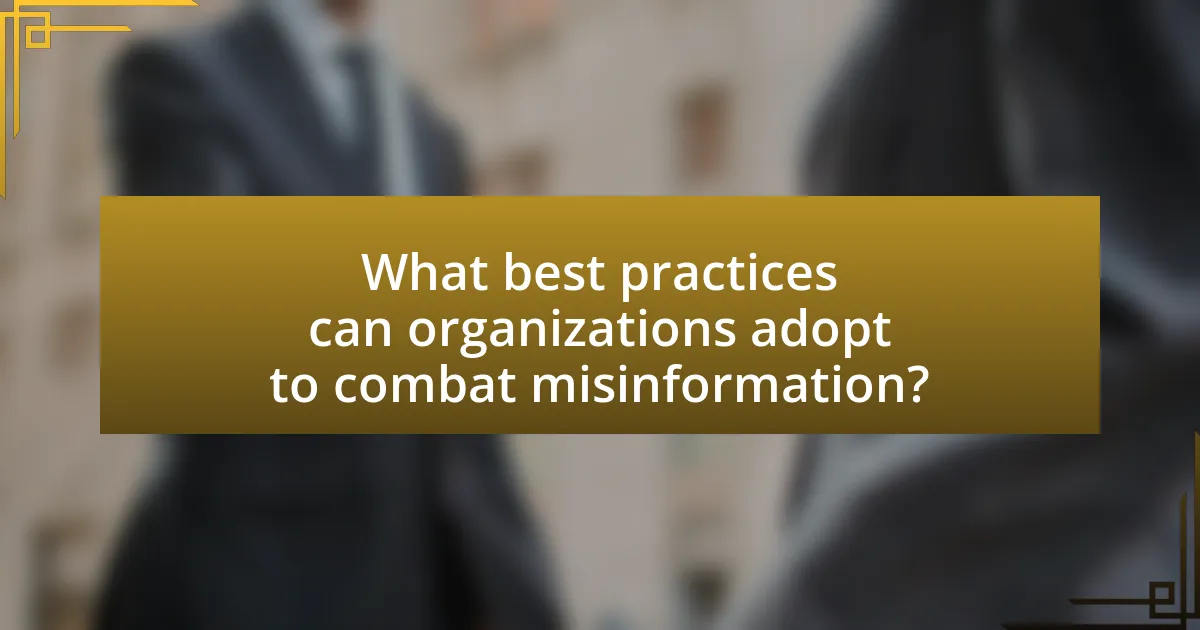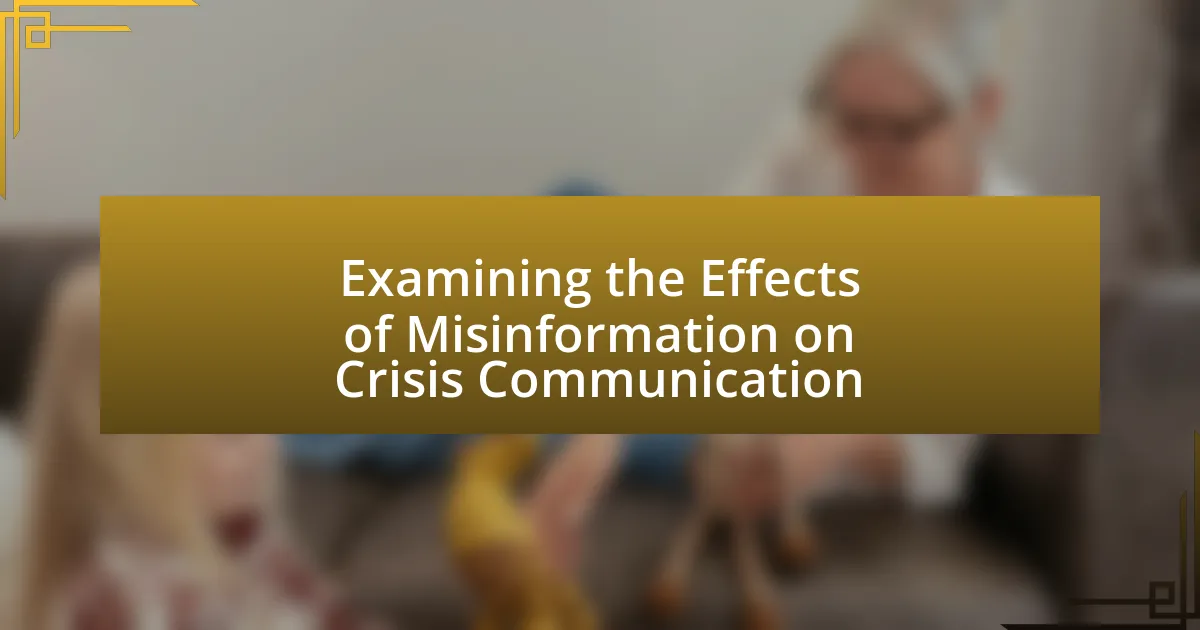The article examines the effects of misinformation on crisis communication, highlighting how it distorts facts and creates confusion, particularly during emergencies like the COVID-19 pandemic. It discusses the primary channels through which misinformation spreads, including social media and traditional media, and emphasizes the significant impact misinformation has on public perception and decision-making. The article also outlines strategies organizations can employ to mitigate misinformation, such as fact-checking, promoting media literacy, and ensuring timely communication, while stressing the importance of transparency and audience engagement in maintaining trust during crises.

What are the effects of misinformation on crisis communication?
Misinformation significantly undermines crisis communication by distorting facts and creating confusion among the public. During crises, accurate information is crucial for effective response and management; however, misinformation can lead to panic, mistrust, and poor decision-making. For instance, a study published in the journal “Health Communication” found that misinformation during health crises, such as the COVID-19 pandemic, resulted in widespread public anxiety and non-compliance with health guidelines. This illustrates how misinformation can exacerbate the impact of a crisis, hinder recovery efforts, and complicate the communication strategies employed by authorities.
How does misinformation spread during a crisis?
Misinformation spreads during a crisis primarily through social media platforms, traditional media, and word of mouth. Social media enables rapid dissemination of unverified information, as users share content without fact-checking, leading to viral spread. A study by the Massachusetts Institute of Technology found that false news stories are 70% more likely to be retweeted than true stories, highlighting the speed and reach of misinformation. Traditional media can also contribute by amplifying sensationalized or misleading reports, while personal communication networks facilitate the spread of rumors and anecdotal claims. This combination of factors creates an environment where misinformation can thrive, complicating crisis communication efforts.
What are the primary channels through which misinformation is disseminated?
The primary channels through which misinformation is disseminated include social media platforms, traditional news outlets, and messaging applications. Social media platforms, such as Facebook and Twitter, facilitate rapid sharing of information, often without verification, leading to widespread dissemination of false narratives. Traditional news outlets can inadvertently spread misinformation through sensational reporting or lack of fact-checking, as seen in various high-profile cases. Messaging applications, like WhatsApp, enable private sharing of information, allowing misinformation to circulate among closed groups, which can amplify its reach. Studies indicate that misinformation spreads faster on social media than factual information, highlighting the significant role these channels play in the crisis communication landscape.
How do social media platforms contribute to the spread of misinformation?
Social media platforms contribute to the spread of misinformation by enabling rapid dissemination of unverified content to vast audiences. The architecture of these platforms, which prioritizes engagement and virality, often amplifies sensational or misleading information over factual reporting. For instance, a study by the Pew Research Center found that 64% of Americans believe that misinformation is a major problem on social media, highlighting the platforms’ role in facilitating the spread of false narratives. Additionally, algorithms that favor emotionally charged content can lead to echo chambers, where users are exposed primarily to information that reinforces their existing beliefs, further entrenching misinformation.
What impact does misinformation have on public perception during a crisis?
Misinformation significantly distorts public perception during a crisis by creating confusion and mistrust. For instance, during the COVID-19 pandemic, false information about the virus’s transmission and treatment led to widespread panic and non-compliance with health guidelines, as evidenced by a study published in the journal “Health Communication,” which found that 70% of respondents encountered misinformation that influenced their behavior. This distortion can result in delayed responses to crises, increased fear, and ultimately hinder effective crisis management efforts.
How does misinformation alter the public’s understanding of the crisis?
Misinformation significantly distorts the public’s understanding of a crisis by creating confusion and fostering distrust in credible sources. When false information spreads, it can lead to misinterpretations of the situation, causing individuals to make decisions based on inaccurate data. For instance, during the COVID-19 pandemic, misinformation about the virus’s transmission and prevention methods led to widespread public panic and non-compliance with health guidelines, as reported by the World Health Organization. This illustrates how misinformation can undermine effective crisis communication, ultimately hindering public health responses and exacerbating the crisis.
What role does fear play in the acceptance of misinformation?
Fear significantly increases the acceptance of misinformation by heightening emotional responses and reducing critical thinking. When individuals experience fear, they often seek immediate answers and reassurance, making them more susceptible to accepting information that aligns with their emotional state, regardless of its accuracy. Research indicates that fear can lead to cognitive biases, such as confirmation bias, where people favor information that confirms their pre-existing beliefs, further entrenching misinformation. For example, during health crises, studies have shown that fear-driven narratives can spread rapidly, as individuals prioritize emotional relief over factual verification, leading to widespread acceptance of false information.
How can organizations mitigate the effects of misinformation?
Organizations can mitigate the effects of misinformation by implementing clear communication strategies and actively monitoring information channels. By establishing a rapid response team, organizations can quickly address and correct false information, thereby reducing its spread. Research indicates that timely and transparent communication can enhance public trust and counteract misinformation effectively. For instance, during the COVID-19 pandemic, organizations that provided regular updates and engaged with their audiences saw a decrease in the dissemination of false information.
What strategies can be employed to counter misinformation?
To counter misinformation, organizations can employ strategies such as fact-checking, promoting media literacy, and utilizing transparent communication. Fact-checking involves verifying claims before dissemination, which can reduce the spread of false information; for instance, the Poynter Institute’s fact-checking initiatives have shown effectiveness in debunking viral misinformation. Promoting media literacy equips individuals with skills to critically evaluate sources and content, as evidenced by studies indicating that media literacy programs can significantly improve people’s ability to discern credible information. Transparent communication fosters trust and clarity, allowing organizations to provide accurate updates during crises, which has been shown to mitigate panic and confusion, as demonstrated in research by the American Psychological Association on crisis communication strategies.
How important is timely communication in crisis management?
Timely communication is crucial in crisis management as it directly influences the effectiveness of response efforts and public perception. Effective communication during a crisis can mitigate panic, reduce misinformation, and ensure that accurate information reaches stakeholders promptly. For instance, a study by the Harvard Kennedy School found that organizations that communicated quickly and transparently during crises were able to maintain public trust and minimize reputational damage. Furthermore, timely updates can help guide appropriate actions among affected populations, as seen during natural disasters where rapid information dissemination has been linked to improved safety outcomes.

Why is understanding misinformation crucial for effective crisis communication?
Understanding misinformation is crucial for effective crisis communication because it directly impacts public perception and response during emergencies. Misinformation can spread rapidly, leading to confusion, panic, and potentially harmful behaviors among the public. For instance, during the COVID-19 pandemic, misinformation about the virus’s transmission and prevention methods contributed to widespread fear and non-compliance with health guidelines, as reported by the World Health Organization. By comprehending the nature and sources of misinformation, communicators can develop targeted strategies to counteract false narratives, ensuring that accurate information reaches the public swiftly and effectively. This understanding enables organizations to maintain trust and credibility, which are essential for effective crisis management.
What are the consequences of failing to address misinformation?
Failing to address misinformation can lead to significant public harm, including the erosion of trust in institutions and the spread of panic. When misinformation goes unchecked, it can result in individuals making decisions based on false information, which can exacerbate crises. For instance, during the COVID-19 pandemic, misinformation about the virus and vaccines led to vaccine hesitancy, contributing to higher infection rates and preventable deaths. A study published in the journal “Health Affairs” found that misinformation significantly influenced public behavior and attitudes, highlighting the critical need for timely and accurate communication to mitigate these consequences.
How can misinformation lead to public panic or unrest?
Misinformation can lead to public panic or unrest by creating false perceptions of danger or urgency. When individuals receive inaccurate information, they may overreact or take drastic measures based on their misinterpretation of the situation. For instance, during the COVID-19 pandemic, misinformation about the virus’s transmission and severity contributed to widespread panic buying and social unrest, as people feared for their health and safety. Studies have shown that misinformation can spread rapidly through social media, amplifying fears and leading to chaotic responses, as evidenced by the surge in violence and protests related to false claims about public health measures.
What long-term effects can misinformation have on trust in organizations?
Misinformation can significantly erode trust in organizations over the long term. When organizations disseminate false or misleading information, it can lead to a breakdown in credibility, as stakeholders may question the reliability of future communications. Research indicates that 70% of consumers are less likely to trust a brand after encountering misinformation associated with it, highlighting the lasting impact on public perception. Furthermore, organizations that fail to address misinformation promptly can experience a decline in customer loyalty and employee morale, as individuals may feel uncertain about the organization’s integrity and transparency. This erosion of trust can result in long-lasting reputational damage, making recovery difficult and costly.
How does misinformation affect decision-making during a crisis?
Misinformation significantly impairs decision-making during a crisis by leading to confusion, panic, and misguided actions. When individuals or organizations rely on false information, they may make choices that exacerbate the situation, such as ignoring safety protocols or misallocating resources. For instance, during the COVID-19 pandemic, misinformation about the virus’s transmission and prevention methods resulted in public health responses that were ineffective and sometimes harmful, as evidenced by the World Health Organization’s reports on the spread of false narratives. This illustrates how misinformation can derail effective crisis management and hinder timely, evidence-based responses.
What challenges do leaders face when misinformation is prevalent?
Leaders face significant challenges when misinformation is prevalent, primarily including the erosion of trust and the difficulty in maintaining clear communication. Misinformation can lead to public confusion, making it hard for leaders to convey accurate information and directives. For instance, during the COVID-19 pandemic, leaders struggled to counteract false narratives about the virus, which undermined public health messages and compliance with safety measures. This situation illustrates how misinformation can create a chaotic environment, complicating decision-making and response efforts. Additionally, leaders must allocate resources to combat misinformation, diverting attention from other critical tasks, which can hinder overall crisis management effectiveness.
How can misinformation influence policy responses to crises?
Misinformation can significantly distort policy responses to crises by creating confusion and misguiding decision-makers. When inaccurate information spreads, it can lead to public panic, misallocation of resources, and delayed responses, as seen during the COVID-19 pandemic where false claims about treatments influenced governmental health policies. For instance, the World Health Organization reported that misinformation about the virus’s transmission and prevention methods hindered effective public health measures, illustrating how misleading narratives can derail timely and appropriate policy actions.

What best practices can organizations adopt to combat misinformation?
Organizations can adopt several best practices to combat misinformation, including implementing fact-checking protocols, promoting media literacy, and fostering transparent communication. Fact-checking protocols involve verifying information before dissemination, which can significantly reduce the spread of false claims. For instance, organizations like the International Fact-Checking Network have established guidelines that help ensure accuracy in reporting. Promoting media literacy equips individuals with the skills to critically evaluate sources and discern credible information, as evidenced by studies showing that media literacy programs can decrease susceptibility to misinformation. Lastly, fostering transparent communication builds trust with audiences, as organizations that openly share information and address concerns are less likely to be seen as sources of misinformation.
How can organizations effectively communicate accurate information?
Organizations can effectively communicate accurate information by implementing clear messaging strategies, utilizing reliable sources, and ensuring timely dissemination of information. Clear messaging involves using straightforward language and avoiding jargon, which helps the audience understand the information without confusion. Utilizing reliable sources, such as verified data from reputable organizations or experts, enhances credibility and trustworthiness. Timely dissemination is crucial, especially during crises, as it prevents the spread of misinformation and keeps stakeholders informed. For instance, during the COVID-19 pandemic, organizations that provided regular updates from health authorities, like the World Health Organization, were more successful in maintaining public trust and compliance with health guidelines.
What role does transparency play in crisis communication?
Transparency is crucial in crisis communication as it fosters trust and credibility between organizations and their stakeholders. When organizations provide clear, accurate, and timely information during a crisis, they mitigate the spread of misinformation and reduce uncertainty. Research indicates that transparent communication can lead to a 20% increase in public trust, as seen in the aftermath of the 2014 Ebola outbreak, where timely updates from health organizations helped to quell fears and misinformation. Thus, transparency not only enhances the effectiveness of crisis communication but also plays a vital role in maintaining public confidence during challenging times.
How can organizations engage with their audience to clarify misinformation?
Organizations can engage with their audience to clarify misinformation by utilizing transparent communication strategies and interactive platforms. By actively sharing accurate information through social media, websites, and community forums, organizations can directly address misconceptions. For instance, a study by the Pew Research Center found that 64% of Americans believe social media has a significant role in spreading misinformation, highlighting the need for organizations to counteract false narratives effectively. Additionally, hosting Q&A sessions and webinars allows organizations to engage in real-time dialogue, fostering trust and providing clarity on complex issues. This proactive approach not only informs the audience but also encourages them to seek reliable sources, thereby reducing the spread of misinformation.
What tools and resources are available to monitor misinformation?
Tools and resources available to monitor misinformation include fact-checking websites, social media analytics tools, and browser extensions. Fact-checking websites like Snopes and FactCheck.org provide verified information on claims circulating online, helping users discern truth from falsehood. Social media analytics tools such as CrowdTangle and Hoaxy track the spread of misinformation across platforms, allowing researchers and organizations to analyze trends and sources. Browser extensions like NewsGuard evaluate the credibility of news websites, offering users insights into the reliability of the information they encounter. These resources collectively enhance the ability to identify and address misinformation effectively.
How can technology assist in identifying and addressing misinformation?
Technology assists in identifying and addressing misinformation through advanced algorithms, machine learning, and data analytics. These tools can analyze vast amounts of data across social media platforms and news outlets to detect patterns indicative of false information. For instance, natural language processing (NLP) techniques can evaluate the credibility of sources and flag content that deviates from established facts. A study by the MIT Media Lab found that false news spreads six times faster than true news on Twitter, highlighting the need for technological intervention. Additionally, platforms like Facebook and Twitter employ AI-driven fact-checking systems that assess the accuracy of shared content, thereby reducing the spread of misinformation.
What partnerships can organizations form to enhance their misinformation strategies?
Organizations can form partnerships with technology companies, academic institutions, and non-profit organizations to enhance their misinformation strategies. Collaborating with technology companies allows organizations to leverage advanced algorithms and data analytics for identifying and countering misinformation effectively. Academic institutions can provide research expertise and insights into the psychological aspects of misinformation, helping organizations understand how misinformation spreads and affects public perception. Non-profit organizations often have established networks and resources for community engagement, which can aid in disseminating accurate information and educating the public about misinformation. These partnerships can be supported by studies, such as the 2020 report by the Pew Research Center, which highlights the importance of collaborative efforts in combating misinformation during crises.
What are the key takeaways for organizations facing misinformation during crises?
Organizations facing misinformation during crises should prioritize clear communication, rapid response, and fact-checking. Clear communication helps establish trust and provides accurate information to counter false narratives. Rapid response is essential to address misinformation before it spreads, as studies show that misinformation can circulate widely within hours. Fact-checking ensures that the information disseminated is accurate, which is crucial for maintaining credibility. For instance, during the COVID-19 pandemic, organizations that quickly corrected misinformation saw a significant reduction in public confusion and panic.

Leave a Reply